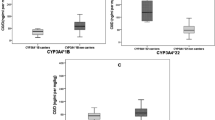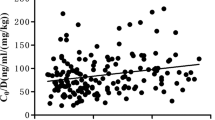Abstract
The aim of this study was to identify novel genetic variants affecting tacrolimus trough blood concentrations. We analyzed the association between 58 single nucleotide polymorphisms (SNPs) across the CYP3A gene cluster and the log-transformed tacrolimus concentration/dose ratio (log (C0/D)) in 819 renal transplant recipients (Discovery cohort). Multivariate linear regression was used to test for associations between tacrolimus log (C0/D) and clinical factors. Luciferase reporter gene assays were used to evaluate the functions of select SNPs. Associations of putative functional SNPs with log (C0/D) were further tested in 631 renal transplant recipients (Replication cohort). Nine SNPs were significantly associated with tacrolimus log (C0/D) after adjustment for CYP3A5*3 and clinical factors. Dual luciferase reporter assays indicated that the rs4646450 G allele and rs3823812 T allele were significantly associated with increased normalized luciferase activity ratios (p < 0.01). Moreover, CYP3A7*2 was associated with higher TAC log(C0/D) in the group of CYP3A5 expressers. Age, serum creatinine and hematocrit were significantly associated with tacrolimus log (C0/D). CYP3A7*2, rs4646450, and rs3823812 are proposed as functional SNPs affecting tacrolimus trough blood concentrations in Chinese renal transplant recipients. Clinical factors also significantly affect tacrolimus metabolism.
This is a preview of subscription content, access via your institution
Access options
Subscribe to this journal
Receive 6 print issues and online access
$259.00 per year
only $43.17 per issue
Buy this article
- Purchase on Springer Link
- Instant access to full article PDF
Prices may be subject to local taxes which are calculated during checkout





Similar content being viewed by others
References
Tron C, Lemaitre F, Verstuyft C, Petitcollin A, Verdier MC, Bellissant E. Pharmacogenetics of membrane transporters of tacrolimus in solid organ transplantation. Clin Pharmacokinet. 2019;58:593–613.
Tang JT, Yan L, Wang LL, Bai YJ, Li YM, Zou YG, et al. A low fixed tacrolimus starting dose is effective and safe in Chinese renal transplantation recipients. Ann Transpl. 2018;23:300–9.
Ekberg H, Tedesco-Silva H, Demirbas A, Vitko S, Nashan B, Gurkan A, et al. Reduced exposure to calcineurin inhibitors in renal transplantation. N. Engl J Med. 2007;357:2562–75.
Vanhove T, Annaert P, Kuypers DR. Clinical determinants of calcineurin inhibitor disposition: a mechanistic review. Drug Metab Rev. 2016;48:88–112.
Kamdem LK, Streit F, Zanger UM, Brockmoller J, Oellerich M, Armstrong VW, et al. Contribution of CYP3A5 to the in vitro hepatic clearance of tacrolimus. Clin Chem. 2005;51:1374–81.
Staatz CE, Tett SE. Clinical pharmacokinetics and pharmacodynamics of tacrolimus in solid organ transplantation. Clin Pharmacokinet. 2004;43:623–53.
Christians U, Jacobsen W, Benet LZ, Lampen A. Mechanisms of clinically relevant drug interactions associated with tacrolimus. Clin Pharmacokinet. 2002;41:813–51.
Prytula A, Cransberg K, Raes A. Drug-metabolizing enzymes CYP3A as a link between tacrolimus and vitamin D in renal transplant recipients: is it relevant in clinical practice? Pediatr Nephrol. 2019;34:1201–10.
Kuehl P, Zhang J, Lin Y, Lamba J, Assem M, Schuetz J, et al. Sequence diversity in CYP3A promoters and characterization of the genetic basis of polymorphic CYP3A5 expression. Nat Genet. 2001;27:383–91.
Li CJ, Li L, Lin L, Jiang HX, Zhong ZY, Li WM, et al. Impact of the CYP3A5, CYP3A4, COMT, IL-10 and POR genetic polymorphisms on tacrolimus metabolism in Chinese renal transplant recipients. Plos One. 2014;9:e86206.
Li L, Li CJ, Zheng L, Zhang YJ, Jiang HX, Si-Tu B, et al. Tacrolimus dosing in Chinese renal transplant recipients: a population-based pharmacogenetics study. Eur J Clin Pharm. 2011;67:787–95.
Tang HL, Xie HG, Yao Y, Hu YF. Lower tacrolimus daily dose requirements and acute rejection rates in the CYP3A5 nonexpressers than expressers. Pharmacogenet Genomics. 2011;21:713–20.
Vannaprasaht S, Reungjui S, Supanya D, Sirivongs D, Pongskul C, Avihingsanon Y, et al. Personalized tacrolimus doses determined by CYP3A5 genotype for induction and maintenance phases of kidney transplantation. Clin Ther. 2013;35:1762–9.
de Jonge H, de Loor H, Verbeke K, Vanrenterghem Y, Kuypers DR. Impact of CYP3A5 genotype on tacrolimus versus midazolam clearance in renal transplant recipients: new insights in CYP3A5-mediated drug metabolism. Pharmacogenomics 2013;14:1467–80.
Liu J, Ouyang Y, Chen D, Yao B, Lin D, Li Z, et al. Donor and recipient P450 gene polymorphisms influence individual pharmacological effects of tacrolimus in Chinese liver transplantation patients. Int Immunopharmacol. 2018;57:18–24.
Press RR, Ploeger BA, den Hartigh J, van der Straaten T, van Pelt J, Danhof M, et al. Explaining variability in tacrolimus pharmacokinetics to optimize early exposure in adult kidney transplant recipients. Ther Drug Monit. 2009;31:187–97.
Birdwell KA, Grady B, Choi L, Xu H, Bian A, Denny JC, et al. The use of a DNA biobank linked to electronic medical records to characterize pharmacogenomic predictors of tacrolimus dose requirement in kidney transplant recipients. Pharmacogenet Genomics. 2012;22:32–42.
Birdwell KA, Decker B, Barbarino JM, Peterson JF, Stein CM, Sadee W, et al. Clinical pharmacogenetics implementation consortium (CPIC) guidelines for CYP3A5 genotype and tacrolimus dosing. Clin Pharm Ther. 2015;98:19–24.
Tamashiro EY, Felipe CR, Genvigir FDV, Rodrigues AC, Campos AB, Hirata RDC, et al. Influence of CYP3A4 and CYP3A5 polymorphisms on tacrolimus and sirolimus exposure in stable kidney transplant recipients. Drug Metab Pers Ther. 2017;32:89–95.
Liu MZ, He HY, Zhang YL, Hu YF, He FZ, Luo JQ, et al. IL-3 and CTLA4 gene polymorphisms may influence the tacrolimus dose requirement in Chinese kidney transplant recipients. Acta Pharm Sin. 2017;38:415–23.
Miura M, Satoh S, Kagaya H, Saito M, Numakura K, Tsuchiya N, et al. Impact of the CYP3A4*1G polymorphism and its combination with CYP3A5 genotypes on tacrolimus pharmacokinetics in renal transplant patients. Pharmacogenomics 2011;12:977–84.
Wang D, Guo Y, Wrighton SA, Cooke GE, Sadee W. Intronic polymorphism in CYP3A4 affects hepatic expression and response to statin drugs. Pharmacogenomics J. 2011;11:274–86.
Elens L, Bouamar R, Hesselink DA, Haufroid V, van der Heiden IP, van Gelder T, et al. A new functional CYP3A4 intron 6 polymorphism significantly affects tacrolimus pharmacokinetics in kidney transplant recipients. Clin Chem. 2011;57:1574–83.
Oetting WS, Wu B, Schladt DP, Guan W, Remmel RP, Mannon RB, et al. Genome-wide association study identifies the common variants in CYP3A4 and CYP3A5 responsible for variation in tacrolimus trough concentration in Caucasian kidney transplant recipients. Pharmacogenomics J. 2018;18:501–5.
Sohn M, Kim MG, Han N, Kim IW, Gim J, Min SI, et al. Whole exome sequencing for the identification of CYP3A7 variants associated with tacrolimus concentrations in kidney transplant patients. Sci Rep. 2018;8:18064.
Oetting WS, Wu B, Schladt DP, Guan W, Remmel RP, Dorr C, et al. Attempted validation of 44 reported SNPs associated with tacrolimus troughs in a cohort of kidney allograft recipients. Pharmacogenomics 2018;19:175–84.
Mohamed ME, Schladt DP, Guan W, Wu B, van Setten J, Keating BJ, et al. Tacrolimus troughs and genetic determinants of metabolism in kidney transplant recipients: A comparison of four ancestry groups. Am J Transpl. 2019;19:2795–804.
Oetting WS, Schladt DP, Guan W, Miller MB, Remmel RP, Dorr C, et al. Genomewide Association Study of Tacrolimus Concentrations in African American Kidney Transplant Recipients Identifies Multiple CYP3A5 Alleles. Am J Transpl. 2016;16:574–82.
Yang X, Zhang B, Molony C, Chudin E, Hao K, Zhu J, et al. Systematic genetic and genomic analysis of cytochrome P450 enzyme activities in human liver. Genome Res. 2010;20:1020–36.
Stephens M, Smith NJ, Donnelly P. A new statistical method for haplotype reconstruction from population data. Am J Hum Genet. 2001;68:978–89.
Gonzalez JR, Armengol L, Sole X, Guino E, Mercader JM, Estivill X, et al. SNPassoc: an R package to perform whole genome association studies. Bioinformatics 2007;23:644–5.
Li J, Chen S, Qin X, Fu Q, Bi H, Zhang Y, et al. Wuzhi tablet (Schisandra sphenanthera Extract) is a promising tacrolimus-sparing agent for renal transplant recipients who are CYP3A5 Expressers: a two-phase prospective study. Drug Metab Dispos. 2017;45:1114–9.
Rodriguez-Antona C, Jande M, Rane A, Ingelman-Sundberg M. Identification and phenotype characterization of two CYP3A haplotypes causing different enzymatic capacity in fetal livers. Clin Pharm Ther. 2005;77:259–70.
Onizuka M, Kunii N, Toyosaki M, Machida S, Ohgiya D, Ogawa Y, et al. Cytochrome P450 genetic polymorphisms influence the serum concentration of calcineurin inhibitors in allogeneic hematopoietic SCT recipients. Bone Marrow Transpl. 2011;46:1113–7.
Li JL, Liu S, Fu Q, Zhang Y, Wang XD, Liu XM, et al. Interactive effects of CYP3A4, CYP3A5, MDR1 and NR1I2 polymorphisms on tracrolimus trough concentrations in early postrenal transplant recipients. Pharmacogenomics 2015;16:1355–65.
GTEx Consortium. The genotype-tissue expression (GTEx) project. Nat Genet. 2013;45:580–5.
McLachlan AJ, Pont LG. Drug metabolism in older people- a key consideration in achieving optimal outcomes with medicines. J Gerontol A Biol Sci Med Sci. 2012;67:175–80.
Passey C, Birnbaum AK, Brundage RC, Oetting WS, Israni AK, Jacobson PA. Dosing equation for tacrolimus using genetic variants and clinical factors. Br J Clin Pharm. 2011;72:948–57.
Tajima S, Yamamoto N, Masuda S. Clinical prospects of biomarkers for the early detection and/or prediction of organ injury associated with pharmacotherapy. Biochem Pharm. 2019;170:113664.
Koop DR, Bleyle LA, Munar M, Cherala G, Al-Uzri A. Analysis of tacrolimus and creatinine from a single dried blood spot using liquid chromatography tandem mass spectrometry. J Chromatogr B Anal Technol Biomed Life Sci. 2013;926:54–61.
Sikma MA, Hunault CC, Huitema ADR, De Lange DW, Van Maarseveen EM. Clinical pharmacokinetics and impact of hematocrit on monitoring and dosing of tacrolimus early after heart and lung transplantation. Clin Pharmacokinet. 2020;59:403–8.
Limsrichamrern S, Chanapul C, Mahawithitwong P, Sirivatanauksorn Y, Kositamongkol P, Asavakarn S, et al. Correlation of hematocrit and tacrolimus level in liver transplant recipients. Transpl Proc. 2016;48:1176–8.
Zhang HJ, Li DY, Zhu HJ, Fang Y, Liu TS. Tacrolimus population pharmacokinetics according to CYP3A5 genotype and clinical factors in Chinese adult kidney transplant recipients. J Clin Pharm Ther. 2017;42:425–32.
Acknowledgements
We would like to give special thanks to all the renal transplant recipients involved in this study. This work was supported by the Natural Science Fund of Guangdong, China (2018A0303130186&2019A1515010100), the Guangdong Science and Technology Foundation (2019B030316032), the Guangxi Natural Science Foundation (2020GXNSFAA159161), and Southern Medical University Innovation Training Program for Undergraduate Students (201812121005&202012121010). Genotype-tissue expression (GTEx) Project was supported by common fund of the Office of the Director of the National Institutes of Health, and by NCI, NHGRI, NHLBI, NIDA, NIMH, and NINDS. The data used for the analyses described in this manuscript were obtained from GTEx Analysis Release V7, dbGaP Accession phs000424.v7.p2.
Author information
Authors and Affiliations
Contributions
DC, HL, and LQL conducted the experiments and drafted the paper. WGS, JX, TY, SY, PZ, YC, JC, WX, QL, QZ, DY, WQ, and LSL collected the samples and data. WS and DW revised the paper. CL and LL designed the study. All authors reviewed and approved the paper.
Corresponding authors
Ethics declarations
Conflict of interest
The authors declare no competing interests.
Additional information
Publisher’s note Springer Nature remains neutral with regard to jurisdictional claims in published maps and institutional affiliations.
Supplementary information
Rights and permissions
About this article
Cite this article
Chen, D., Lu, H., Sui, W. et al. Functional CYP3A variants affecting tacrolimus trough blood concentrations in Chinese renal transplant recipients. Pharmacogenomics J 21, 376–389 (2021). https://doi.org/10.1038/s41397-021-00216-w
Received:
Revised:
Accepted:
Published:
Issue Date:
DOI: https://doi.org/10.1038/s41397-021-00216-w



